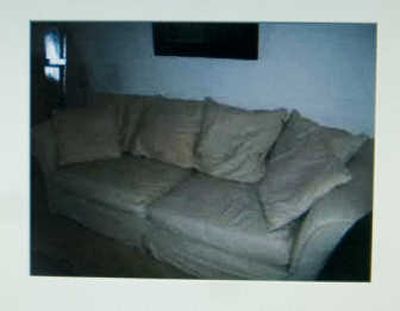Jailhouse chic

Kris Fiala loves her newly reupholstered couch. And it makes for a great conversation piece, too. She bought the sofa for a few hundred dollars off Craigslist, and then had it re-covered by inmates. Yes, inmates. From Airway Heights Corrections Center.
“It’s gorgeous,” says Fiala, a 44-year-old Spokane resident. “They did a super job. It’s beautiful.”
Fiala’s couch, now covered in tan microfiber fabric, was reupholstered through a Correctional Industries program, one of two upholstery programs housed at the correctional facility.
“It’s like a brand-new couch,” Fiala says.
Fiala brought her Craigslist couch – then draped in a slipcover her husband didn’t like – to the Salvation Army on Division Street. She also brought along enough fabric to cover the couch.
In about two months, Fiala had a new piece of furniture for her living room, at about half the price, she says, of going through a standard upholstery shop.
But you can’t be in a hurry to take part in this program. The Correctional Industries program, through the Salvation Army, is undeniably popular.
“Right now we’re booked clear up until the first of the year,” says Lou Morlin, store supervisor for the Salvation Army.
If you can’t wait, you can find the upholstery work of Airway Heights inmates at stores around the area.
The facility hosts a one-year certificate program in upholstery, taught by a Community Colleges of Spokane instructor. Graduates of that program can then opt to continue on to the Correctional Industries program.
Upholstered furniture done by students in the certificate program is then sold at the end of each quarter to the Salvation Army, Northwest Christian Schools Thrift Store, Revival Lighting and other retail spots at prices much lower than furniture stores.
Many of the inmates in the programs have gone on to careers in upholstery after serving their sentences. Instructor Ron Pearson keeps a book filled with pictures of former inmates and their couches and wing-back chairs, along with details of where they’re working today.
“We see a lot of really good results,” Pearson says. “We have a lot of former students in the trade.”
Only inmates with good disciplinary records are allowed in class, and they are searched from head to toe on the way out each day to make sure they aren’t taking anything out of the work area.
On a recent day, Francisco Vasquez, 23, and other inmates in the certificate program worked at tables spread out around a large shop. Vasquez has spent about three months in the program and says he hopes to go into upholstery when his sentence “for violent crimes” ends in two years.
“I just want something for when I get out,” says Vasquez, who has learned how to make box pleats and diamond tufting, among other skills. “It’s changed my whole idea of being incarcerated. I want to be here. I want to be in this class.”